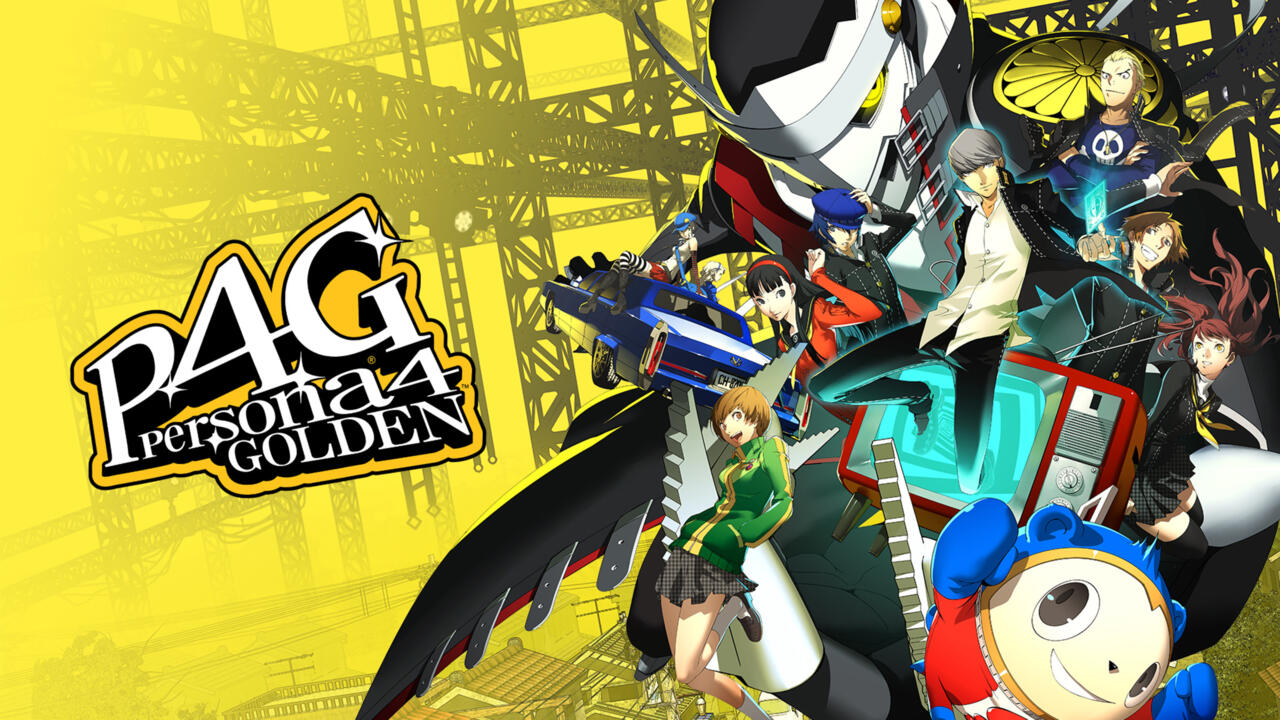
A top-tier role-playing game is generally a finely crafted concoction of several ingredients: an interesting setting, an engaging story, enjoyable characters and interactions, and gameplay that makes your interaction with all of the aforementioned elements feel meaningful and worthwhile. When all of these individual factors are developed to high standards, the result is an RPG of exceptional quality–and that is exactly what Persona 4 Golden is.
This re-release of 2008’s excellent PlayStation 2 game takes place in modern-day Japan. The protagonist is a high school student from a big city whose parents have been sent away on business. They send him to live for a year with his uncle–a police investigator–and his young cousin in a small countryside town. Almost immediately upon the hero’s arrival, strange things begin to happen in this otherwise dull little hamlet: a string of people turn up dead, and rumor spreads of a supernatural television broadcast that shows bizarre programming. The hero and a crew of his newfound classmates soon discover a horrible secret: there’s a separate world within the televisions that twists human desires and hidden feelings in potentially lethal ways, and it’s somehow tied to the serial killings. It’s up to the group of friends to harness the supernatural power of personas, put a stop to the sinister killing spree, and decipher the secrets behind the TV world.
The contemporary, real-world-inspired setting of Persona 4 is already an excellent conceit in the heavily fantasy- and sci-fi-driven world of RPGs. But it’s far from the only element that sets the game apart from the crop. Unlike most RPGs, Persona 4 operates on something of a time limit. From the day you arrive in the country village of Inaba until the day the school year ends, you advance through the game on a calendar. Dates and deadlines are very important; not only do you have important events in school and in your personal life to deal with, but you also discover that the serial killings follow a specific time pattern. You need to explore and rescue potential victims from the TV world before they are killed–a task that usually takes several days to complete.
It would be easy if you could just spend all your days fighting, but Persona 4 also puts heavy emphasis on interacting with other characters in the game. Every day presents many opportunities for various noncombative activities, be it school clubs, hobbies at home, working part-time jobs for extra spending money, or just hanging out with pals needing friendly support. Spending time on these activities benefits you in various ways: some boost your abilities, some earn you items and money, and still others increase your connections with other characters.
Some choices can even offer multiple benefits. By far the most lucrative are the connections with non-player characters, called “social links.” By forming friendships and support networks with various characters, you create powerful personas to use during combat. (Some social links, such as those with your party members, also offer additional combat benefits and skills.) Thus, choosing how to spend your limited time each day becomes an additional challenge with its own risks and rewards. If you feel indecisive, an in-game feature lets you connect to an online database to see how other players chose to spend that day.
Though social links pose an engaging puzzle, they woudn’t be nearly as interesting if the NPCs involved weren’t engaging, memorable characters. This is one of the ways Persona 4 shines, since interacting with the game’s cast is enjoyable and rewarding in itself. The characters you meet over the course of the game are relatable and believable, as are the struggles they go through. The bonds you wind up forming with characters make the various interludes scattered throughout the game (such as class trips and group vacations) even more enjoyable as breaks from a sometimes very heavy story. The quality of the game’s writing and localization is an additional triumph, skillfully delivering both laugh-out-loud moments and heart-wrenching plot twists.
The story and socialization elements are only one portion of the game, however. You spend a lot of time exploring the TV world, as well. As the game progresses, the TV world expands to include numerous dungeons and monsters created from the dark, repressed thoughts of potential victims that have been cast inside. As the leader of your school friends’ makeshift “investigation team,” you and your pals explore these randomly generated dungeons, scouring them for treasures and occasionally solving puzzles while searching for the abducted victims. Combat is traditional turn-based RPG fighting with a twist: both you and your foes can earn extra turns by exploiting each other’s elemental weakness, a mechanic that fuels some devious strategies and devastating attacks. (It’s worth noting that Persona 4 Golden is slightly easier than the original game, so veterans looking for a challenge may want to pick a harder difficulty setting when starting a new game.)
The concept of “personas”–supernatural representations of one’s projected self–comes into play during combat. Personas come with a set of strengths, weaknesses, and combat skills, which can change and evolve as the personas level up. While your party members each have a set persona throughout the game, your lead character has the unique ability to transform into many different personas during combat. This allows for additional combat strategy, giving you a way to select personas ideal for exploiting enemy weaknesses while also working to protect your own party. The main character’s personas also gain experience and level up independently of his base level, usually being equal to or lower than his own.
Since eventually personas learn all of the skills they possibly can and taper off in stat growth, you need to explore the system of fusing personas to form new, more-powerful personas in combat. This allows skills from the personas used in the fusion to be passed along, and some well-planned skill inheritance combinations can result in a potent new combat persona. Social links also boost created personas with additional experience bonuses, allowing you to create much higher-level personas typically beyond your reach. Skillfully creating a persona array to use in battle can often mean the difference between victory and defeat.
These various elements improve an already-fantastic RPG experience. But what makes Persona 4 Golden an even more impressive package is how much extra content has been packed into the game over its original release. For starters, creating new personas via fusion is much easier, because the game lets you pick skills to transfer (rather than randomly transferring skills). You can also give personas specific abilities through the use of rare items called “skill cards”–a callback to some of the earlier Persona games.
Your party members are also capable of performing additional abilities during combat: depending on how high your social links are with your teammates, they can randomly cure minor status ailments and perform support attacks–even if they aren’t in the currently active party. Certain combinations of party members can also perform special follow-up skills after all-out attacks to deal extra damage to already weakened foes. The Shuffle Time card minigame after certain battles has been completely redone, allowing for less random chance and more worthwhile bonuses. A network feature in dungeons rounds out the combat enhancements, allowing you to request help from other P4G players connected to PSN to deliver aid in the form of health and skill point recovery.
The improvements go well beyond combat. Two new social links–including a brand-new female character named Marie–are available to foster, and additional locations and opportunities for building other links abound. You can buy seeds and tend to a garden at home, using the crops yielded as helpful items in the dungeons. You also earn a scooter during the game, which you can use to travel to the beach and a larger city for activities, shopping, and questing. More options are available to you during the evenings, including hanging out with friends and a new job opportunity working at a hostess bar. Finally, many activities from the previous game, such as reading or working at home in the evenings to improve various stats, have been streamlined to be easier to use and more beneficial.
But these aren’t even the biggest additions to the game. In the original release of P4, there was a point where a significant time skip occurred, moving the game’s calendar several months ahead. In Persona 4 Golden, much of this time period is made available to you to play through, allowing you to further build social links and engage with the characters and setting well beyond what you could before. Some new story events are available during this time, and a completely new dungeon also opens up (provided you’ve completed some prerequisites). The new story additions also allow for some vastly different endings.
On top of everything are separately accessible in-game TV channels that offer a variety of programming. Once you unlock them, you can freely access archives of the various animation sequences seen in the game, design artwork, and promotional materials and music. There’s even a lesson on the Jungian psychology theories that form the basis of the game’s story, along with an interactive quiz-show series that tests your knowledge of everything related to Persona 4.
As great as Persona 4 Golden is, there are a few minor issues. The game still takes a while to get going: expect to experience about two hours of plot setup and character introductions before you’re turned loose to enjoy the game at your own pace. The visual upgrade also feels a little lacking: P4G’s PlayStation 2 roots show in its fairly basic-looking character models and environments and sometimes-blurry textures. The game looks like an HD remaster rather than a full remake, leaving you feeling like it doesn’t take advantage of the platform’s graphical capabilities as well as it should.
When it comes down to it, however, any complaints that can be lobbied at Persona 4 Golden feel insignificant when weighed against the quality of the rest of the game. Persona 4 remains one of the most engaging, thoughtful, and enjoyable RPGs of recent years, having already earned its status as a genre classic upon its original release. Persona 4 Golden’s well-thought-out and well-implemented augmentations serve to make an already fantastic game even better, resulting in a superlative game experience that belongs in any Vita game library.
Persona 4 Golden (2023)
When a fantastic game finds itself wedged between two entries of a similar caliber, it always runs the unfortunate risk of looking a bit dimmer by comparison. Persona 3 is a macabre masterpiece–a hazy blue exploration of death and how to live life so purposefully you can one day hope to embrace it rather than fear it. Persona 5, on the other hand, exudes confidence and demands action rather than somber meditation. It is a game that doubles as a call for authenticity and the courage to rebel–to stand your ground and resist cruel authoritarians. So, with two phenomenal titles resting gently on either side of it, what does that mean for Persona 4 Golden?
As its name implies, Persona 4 Golden remains absolutely radiant. Even in 2023–and up against the polish of modern-day titles and the nostalgia we attach to those older than it–it is not only an incredible entry in the Persona series, but an incredible RPG. Persona 4 Golden’s intimate nature, charming cast of characters, and idyllic setting carefully built to juxtapose its tense and horrific narrative, create an experience that is unforgettable and worthy of its critical acclaim.
As this is a brief review following Persona 4 Golden being ported to modern consoles, I won’t regale you with all the same information regarding plot details and mechanics you can find in our 2012 review. No major changes have been made to the game and the high-praise given to in our review still stands. However, 11 years feels like a sufficient amount of time to reflect on parts of the game that deserved to be reexamined, for better or worse.
A part of the game that has aged incredibly well and sets Persona 4 Golden apart from its peers is its intimate scale. While it doesn’t feel completely accurate to say that the game’s stakes are significantly smaller–we’re still talking alternate dimensions, gods, and murder here–the rural setting and tendency for all action, mystery, and tragedy to center around core group of people makes every plot beat that much punchier. Additionally, whereas Persona 3 and Persona 5 present you as an outsider in a big city, in Persona 4 you are a city boy welcomed into a small town. Rather than subsiding on dorm food or hurriedly eating curry whilst being berated, you enjoy your meals with your family and spend plenty of quality time around the kotatsu. Despite how eerie the game can be and explicit with its violence, there is a warmth that permeates and offers comfort through the hardship.

This is only amplified by how fantastic Persona 4 Golden’s characters and the moments you share with them. While most RPGs have a few characters that feel lackluster compared to the rest of the party, Persona 4 has an exceptionally solid cast. Sure, you might be a Teddy hater–I totally get it if you are–but overall the characters in the game are more fully-fleshed out and personable than the majority of games out there. By the time I rolled credits, I was heartbroken that the time I spent beside them had come to an end. I wanted more animated cutscenes feeding me fan service. I longed to go to Junes with Nanako one more time, or see Yoske finally mature a bit and perhaps even ask Chie out on a date. I suppose it all boils down to, rather than feeling like you were fighting to fit in or raise social links to gain a sense of belonging, that sensation is baked right into the game’s DNA. It’s an impressive feat that makes it among the most charming of games I’ve ever played.
However, even Persona 4 Golden’s charms don’t lessen the impact of some of the story beats that did not age quite as well as the rest of the game. While Persona 4 is a game all about belonging and adolescents reckoning with their inner-self to become the person they long to be, both Kanji and Naoto’s storylines go against this premise and don’t quite make sense. Throughout the game, Kanji discovers he feels attraction towards men while Naoto repeatedly expresses his desire to present himself as a man. However, both Kanji’s sexuality and Naoto’s identity are ultimately written off as temporary feelings they experienced because of–wait for it–women.
Kanji states he saw men in a sexual light because he viewed women as overly critical, while Naoto reveals he chooses to present male because women don’t fall in line with his perception of a cool and aloof detective. While these are the most prevalent cases of Persona 4 dismissing or outright laughing off its opportunities to explore queer identities, the game also features several additional instances of homophobic and sexist language. While we could chalk this all up to culture or call Persona 4 Golden a reflection of the times, these situations ultimately sour the game’s overall experience–especially when you consider how harshly they clash against Persona 4’s message of acceptance and its kindhearted characters.
Moving on from the game’s setting and characters, however, I do find a few areas where I actually think more praise is in order. For example, I believe that criticism in our original review towards the game’s art and slow start don’t ring quite as true to me. I appreciate how ornate places feel in Persona 4 Golden–how filled to the brim every environment feels, regardless of whether it’s a dungeon or a small shop. While the fidelity might not be there, the artistry is, and everything feels very intentionally designed to evoke a particular feeling, be it comfort or unease. I also think that, especially in 2023, slower starts to games are a lot more expected and accommodating, making Persona 4 Golden’s slow burn far less grating than it might have been in 2012.
Over a decade later, Persona 4 Golden offers up the same warmth and radiance its name implies. The ease at which the game can leverage atmosphere and emotion is remarkable and not easily emulated. And while Persona 3 might boast a profound story and Persona 5 an abundance of style and flash, it is that intimate atmosphere–that sense of closeness and belonging–that sets Persona 4 apart from both of them. Though parts of its social commentary are ignorant and regressive, there is an underlying tenderness and sincerity that shines through most other portions of the game and make it a must-play.


